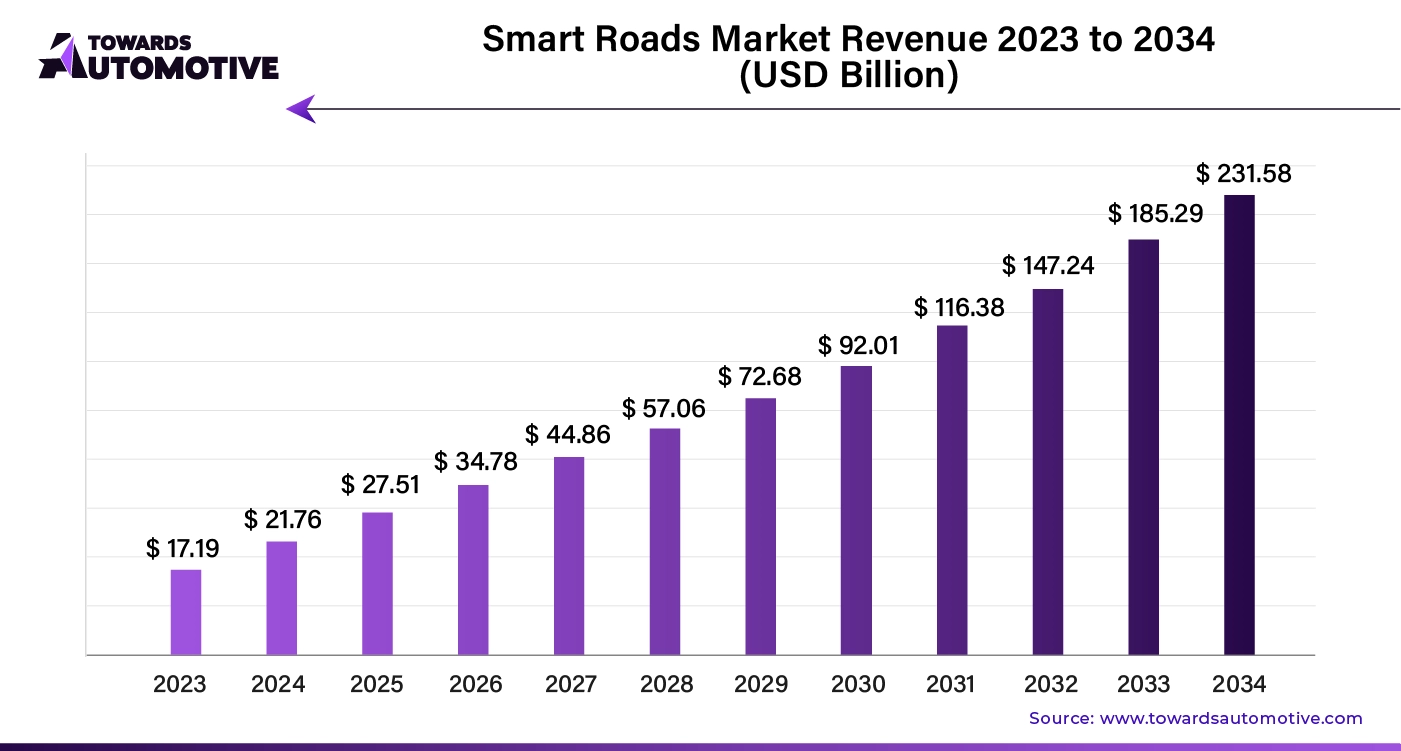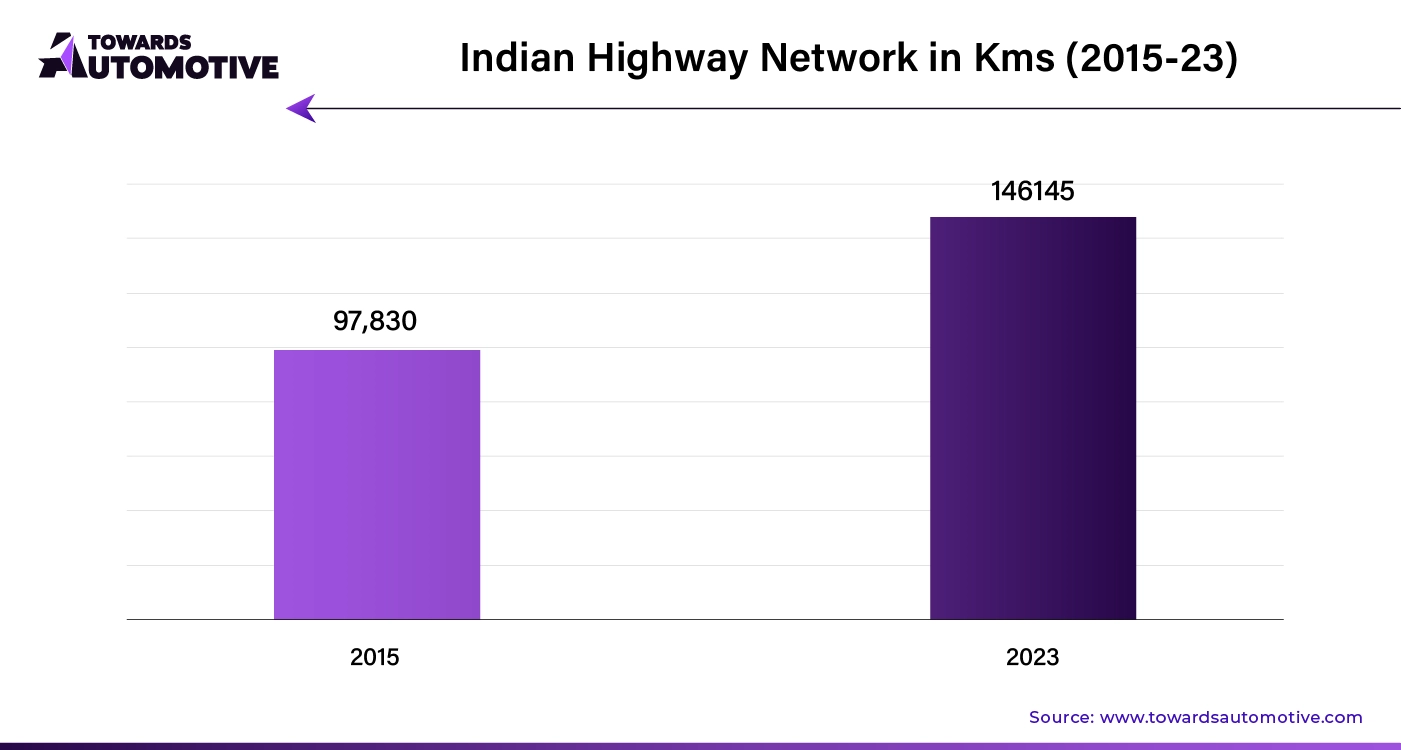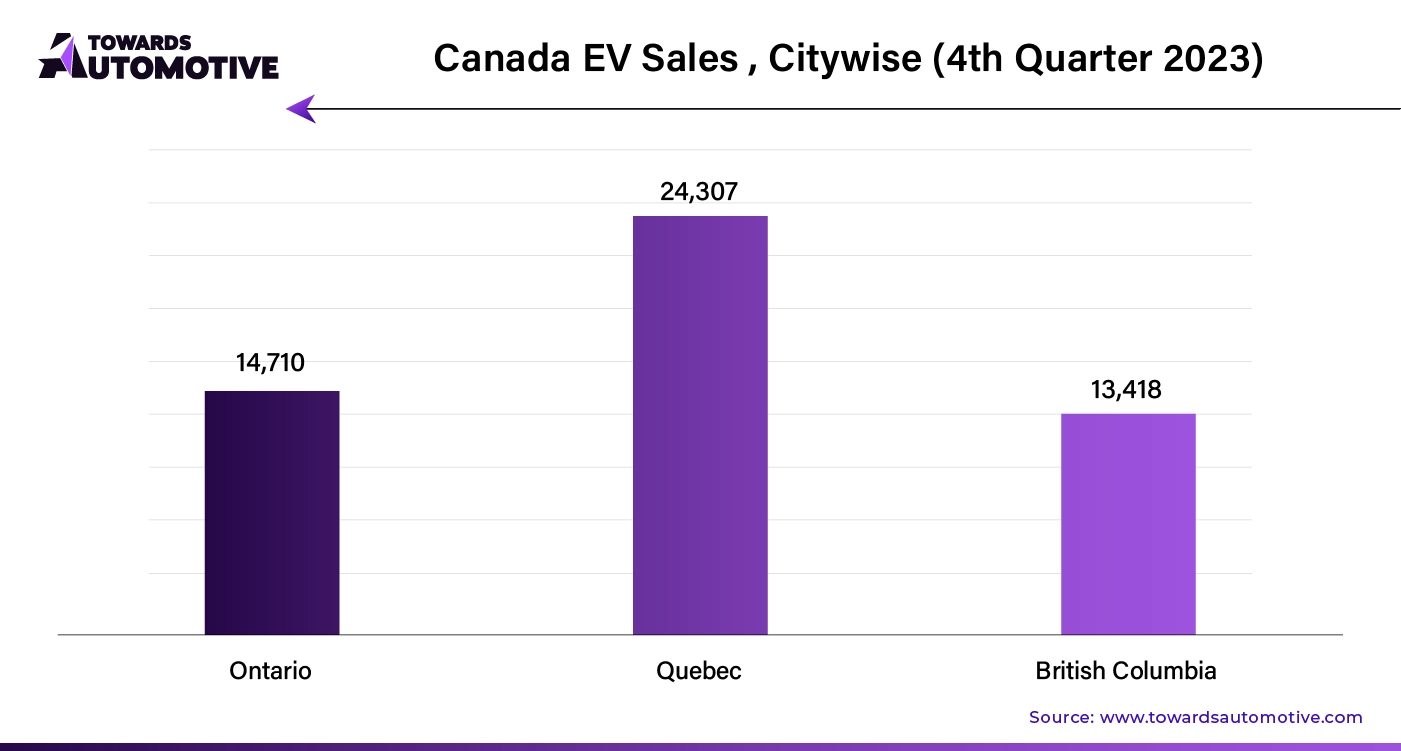March 2025

Senior Research Analyst

Reviewed By
The global smart roads market size is calculated at USD 21.76 billion in 2024 and is expected to be worth USD 231.58 billion by 2034, expanding at a CAGR of 26.65% from 2024 to 2034.

The smart roads market is rapidly gaining momentum as advancements in technology and increasing concerns about road safety and efficiency reshape the transportation infrastructure landscape. Smart roads incorporate sensors, IoT devices, and communication systems to enhance traffic management, reduce accidents, and optimize road maintenance. Governments and private sectors worldwide are investing heavily in smart road initiatives to create safer, more sustainable, and efficient transportation networks. These roads are equipped with intelligent features such as dynamic lane management, real-time traffic monitoring, and vehicle-to-infrastructure communication, facilitating the integration of autonomous and electric vehicles into modern traffic systems.
The growing need to reduce congestion, lower emissions, and enhance overall road safety is driving the demand for smart roads. Moreover, the push toward sustainable urbanization and the adoption of intelligent mobility solutions are fueling the market's expansion. With rising investments in infrastructure development and technological innovations, the smart roads market is poised for substantial growth in the coming years, transforming how transportation systems operate globally.
Artificial intelligence (AI) plays a transformative role in the smart roads market by enabling intelligent decision-making, predictive analytics, and automation, which enhance road safety, efficiency, and sustainability. AI powers various key components of smart roads, including traffic management, accident prevention, and real-time monitoring systems. Through the integration of AI with sensors, cameras, and IoT devices, smart roads can collect vast amounts of data on traffic patterns, road conditions, and vehicle behavior.
One of the primary roles of AI in smart roads is optimizing traffic flow. AI-driven traffic management systems use real-time data to predict congestion, adjust traffic signals dynamically, and reroute vehicles, reducing delays and improving fuel efficiency. Additionally, AI enhances safety by detecting hazardous conditions such as icy roads, accidents, or obstacles, and communicating alerts to nearby vehicles, preventing collisions.
AI also supports the integration of autonomous vehicles (AVs) by enabling vehicle-to-infrastructure (V2I) communication, where smart roads interact with AVs to guide their navigation and ensure safer, more efficient driving. Moreover, AI-driven predictive maintenance systems analyze road conditions, identifying wear and tear or potential issues, allowing timely repairs and reducing long-term infrastructure costs. Overall, AI is pivotal in driving the evolution of smart roads by creating more intelligent, responsive, and sustainable transportation networks.
The rising demand for highways and road infrastructure is a key driver propelling the growth of the smart roads market. As urbanization accelerates and global populations grow, the need for efficient, safe, and sustainable transportation systems becomes increasingly urgent. Traditional road networks are struggling to keep pace with traffic congestion, accidents, and environmental challenges, leading governments and private investors to seek innovative solutions. This demand has catalyzed investments in smart road technologies, which incorporate sensors, IoT devices, and AI-powered systems to enhance road safety, optimize traffic management, and support vehicle-to-infrastructure (V2I) communication.
The expansion and modernization of highways and road infrastructure offer an ideal platform for deploying smart road technologies, creating a more connected and intelligent transportation network. As countries invest in building and upgrading roadways to support economic growth, smart roads provide a future-proof solution that improves traffic flow, reduces emissions, and enhances overall road safety. Moreover, the integration of these technologies supports the growing adoption of autonomous and electric vehicles, aligning with global sustainability goals. The increasing focus on upgrading infrastructure to meet the demands of modern transportation systems is expected to accelerate the growth of the smart roads market in the coming years.

The smart roads market faces several restraints that could hinder its growth. High initial costs of implementation, including the installation of advanced sensors, IoT devices, and AI systems, are a significant barrier for many regions, especially in developing economies. Additionally, the lack of standardized technology and regulations complicates large-scale adoption and interoperability between different systems. Concerns over data privacy and cybersecurity risks associated with connected infrastructure also present challenges. These factors, combined with long project timelines, may slow the widespread deployment of smart road technologies.
The development of solar-powered roads is creating significant opportunities in the smart roads market, as it combines sustainability with innovative infrastructure solutions. Solar-powered roads utilize photovoltaic (PV) cells embedded in the road surface to generate electricity, transforming traditional roadways into energy-producing assets. This development not only supports green energy goals but also opens up new avenues for integrating intelligent transportation systems. The energy produced by solar roads can be used to power streetlights, traffic signals, and even electric vehicle (EV) charging stations, making roadways more self-sufficient and reducing reliance on external power sources.
In addition to enhancing energy efficiency, solar-powered roads align with global efforts to reduce carbon emissions and promote sustainability, attracting investments from governments and private sectors. These roads can also be equipped with smart sensors and IoT devices, improving real-time traffic management, vehicle-to-infrastructure (V2I) communication, and road safety. Furthermore, solar roads create potential for innovative business models, such as selling surplus energy back to the grid. The integration of renewable energy with intelligent infrastructure positions solar-powered roads as a key driver of growth in the smart roads market, offering a futuristic, eco-friendly solution to modern transportation challenges.
The hardware segment held the largest share of the market. The hardware segment is a critical driver of growth in the smart roads market, as it provides the foundational technology necessary for creating intelligent and efficient road systems. This segment encompasses a range of components, including sensors, cameras, control units, and communication devices, all of which play essential roles in the functionality of smart roads. Advanced sensors and cameras are used for real-time monitoring of traffic conditions, road wear, and environmental factors, while control units manage and process this data to optimize traffic flow and enhance road safety. Communication devices enable seamless vehicle-to-infrastructure (V2I) interaction, supporting features such as dynamic traffic signals and incident detection.
As smart roads evolve, the demand for sophisticated hardware that can integrate with emerging technologies, like artificial intelligence (AI) and the Internet of Things (IoT), is growing. Innovations in hardware are crucial for supporting the advanced functionalities of smart roads, including real-time traffic management, predictive maintenance, and automated vehicle communication. Additionally, investments in hardware are essential for implementing large-scale smart road projects and ensuring their effectiveness. The continual advancements and increased adoption of smart road hardware are driving the market forward, paving the way for more intelligent, efficient, and safer transportation infrastructure.
The cloud segment dominated the industry. The cloud segment is a pivotal driver of growth in the smart roads market, as it provides the necessary infrastructure for managing and analyzing the vast amounts of data generated by intelligent road systems. Cloud computing enables the centralized storage and processing of data collected from various sensors, cameras, and IoT devices embedded in smart roads. This data is essential for real-time traffic management, predictive maintenance, and effective vehicle-to-infrastructure (V2I) communication. The scalability and flexibility offered by cloud solutions allow for the integration of advanced analytics, artificial intelligence (AI), and machine learning, enhancing the capabilities of smart road technologies.
By leveraging cloud platforms, smart road systems can efficiently handle large volumes of data, ensuring timely and accurate decision-making. Cloud-based solutions also facilitate seamless updates and upgrades to smart road applications, improving their functionality and performance over time. Moreover, the cloud's ability to support remote access and data sharing among various stakeholders—such as traffic management centers, government agencies, and maintenance teams—enhances collaboration and operational efficiency. As the demand for smarter, more responsive transportation infrastructure grows, the cloud segment's role in providing scalable, data-driven solutions becomes increasingly critical to the advancement and expansion of the smart roads market.
The intelligent transport management system segment led the market. Intelligent Transport Management Systems (ITMS) are a key catalyst in the growth of the smart roads market, driving advancements in traffic management, safety, and overall road efficiency. ITMS integrates a range of technologies, including sensors, cameras, and data analytics platforms, to monitor and control traffic flows in real-time. By leveraging these systems, smart roads can optimize traffic signal timings, manage congestion, and provide real-time updates to drivers, enhancing road safety and reducing travel time.
The adoption of ITMS enables advanced features such as adaptive traffic control, incident detection and response, and predictive maintenance, which significantly improve the functionality of road infrastructure. These systems facilitate better coordination between different transportation modes and streamline the integration of autonomous vehicles, contributing to a more efficient and cohesive transportation network. Additionally, ITMS supports data-driven decision-making by analyzing traffic patterns and infrastructure performance, helping cities and regions to plan and implement more effective transportation strategies.
As urbanization and traffic demands increase, the need for sophisticated transport management solutions becomes more pressing. ITMS not only addresses these challenges but also drives innovation and investment in smart road technologies, further propelling the growth of the smart roads market and paving the way for a more intelligent and sustainable transportation future.
North America dominated the smart roads market. The adoption of autonomous and electric vehicles (EVs), rising urbanization and congestion, and a growing focus on sustainability are key drivers fueling the growth of the smart roads market in North America. As autonomous and electric vehicles gain momentum, the need for advanced infrastructure capable of supporting vehicle-to-infrastructure (V2I) communication, real-time traffic management, and efficient EV charging solutions is increasing. Smart roads, equipped with sensors, IoT devices, and AI-powered systems, are essential to accommodate the seamless integration of these next-generation vehicles, optimizing traffic flow, reducing accidents, and improving energy efficiency.
Urbanization is rapidly intensifying in North American cities, leading to higher levels of traffic congestion and putting pressure on existing road infrastructure. Smart roads offer innovative solutions such as dynamic lane management, intelligent traffic signals, and real-time monitoring systems to alleviate congestion, enhance road safety, and improve overall transportation efficiency. These advancements are critical in addressing the growing demand for smarter, more resilient infrastructure in expanding urban areas.
In addition, the region’s focus on sustainability is driving the integration of eco-friendly technologies, such as solar-powered roads and energy-efficient street lighting, into smart road projects. These developments align with global efforts to reduce carbon emissions and promote greener transportation solutions. By incorporating renewable energy and intelligent systems, smart roads in North America are not only enhancing road safety and efficiency but also contributing to the region’s environmental goals, further accelerating the market's growth.

Asia Pacific is expected to grow with a significant CAGR during the forecast period. Technological advancements, a focus on green infrastructure, and rapid infrastructural development are key drivers of the smart roads market in the Asia Pacific region. The region is witnessing significant progress in technologies like artificial intelligence (AI), 5G, and the Internet of Things (IoT), which are transforming road systems into intelligent, data-driven networks. These technologies enable real-time traffic management, vehicle-to-infrastructure (V2I) communication, and predictive maintenance, enhancing road safety and efficiency. As countries in Asia Pacific embrace smart transportation solutions, the integration of advanced technologies is accelerating the growth of the smart roads market.
Additionally, the growing emphasis on sustainable and green infrastructure is playing a pivotal role in driving market expansion. Governments and private sectors in the region are prioritizing eco-friendly solutions that reduce carbon emissions and promote energy efficiency. Smart roads equipped with energy-efficient street lighting, solar-powered surfaces, and environmental monitoring systems align with these sustainability goals, making them an attractive option for modern infrastructure projects.
Furthermore, rapid infrastructural development across Asia Pacific, especially in fast-growing economies like China and India, is creating a strong demand for smart road technologies. As urbanization accelerates and traffic congestion increases, the need for intelligent roadways capable of optimizing traffic flow, improving safety, and reducing travel time becomes more pressing. Investments in large-scale infrastructure projects, along with the region’s commitment to innovation and sustainability, are driving the robust growth of the smart roads market in Asia Pacific.
By Component
By Application
By Region
March 2025
March 2025
March 2025
March 2025
Dr. Arjun Patel is a distinguished expert in the automotive industry, holding advanced degrees in Automotive Engineering and Mechanical Engineering. His expertise spans automotive market dynamics, technological advancements, and sustainable practices. Dr. Patel excels in conducting in depth research and analysis on market trends, consumer preferences, and the economic implications within the automotive sector. He is renowned for his insightful publications on topics such as electric vehicles, autonomous driving technologies, and the evolution of sustainable transportation solutions. Dr. Patels research contributions have significantly advanced understanding in the field, earning him recognition as a leading authority in automotive research and analysis.
We offer automotive expertise for market projections and customizable research, adaptable to diverse strategic approaches.
Contact Us